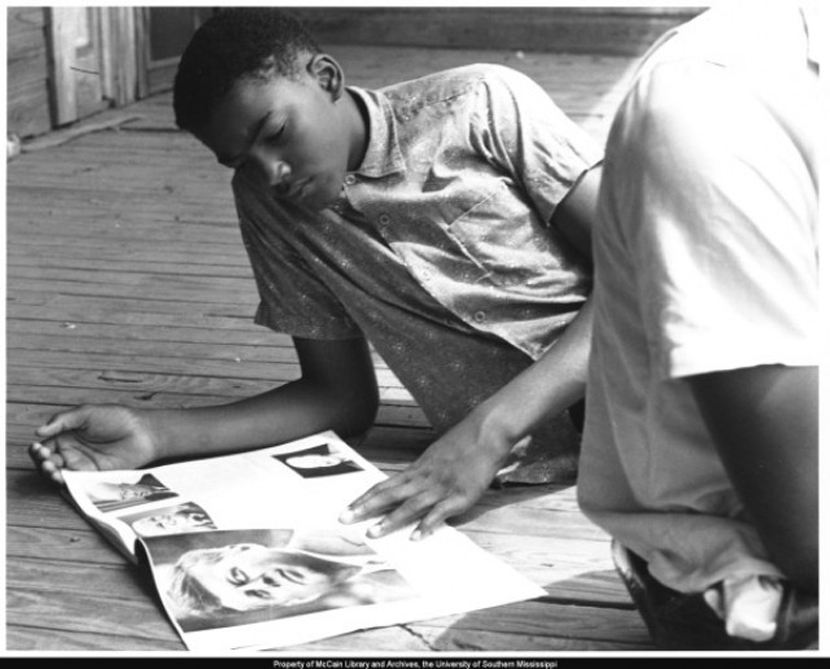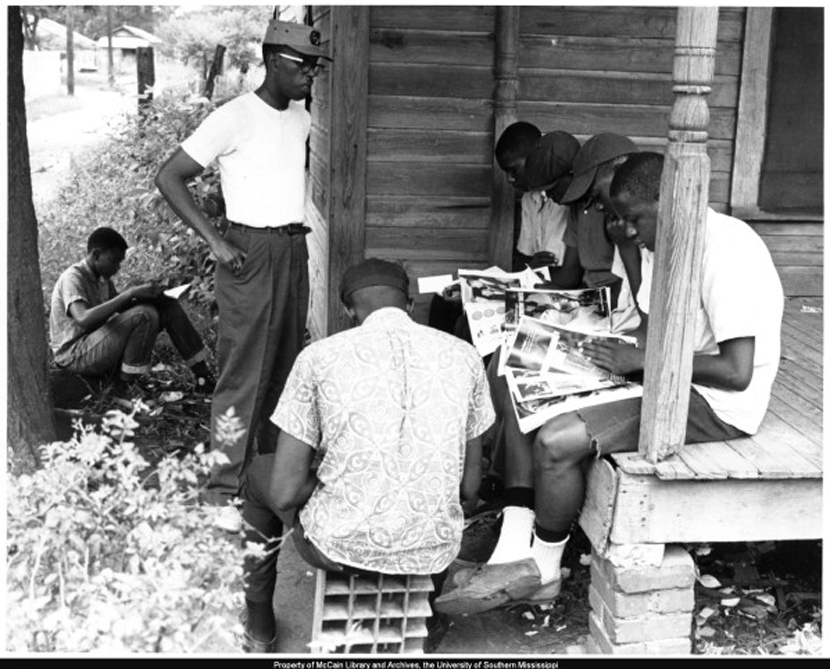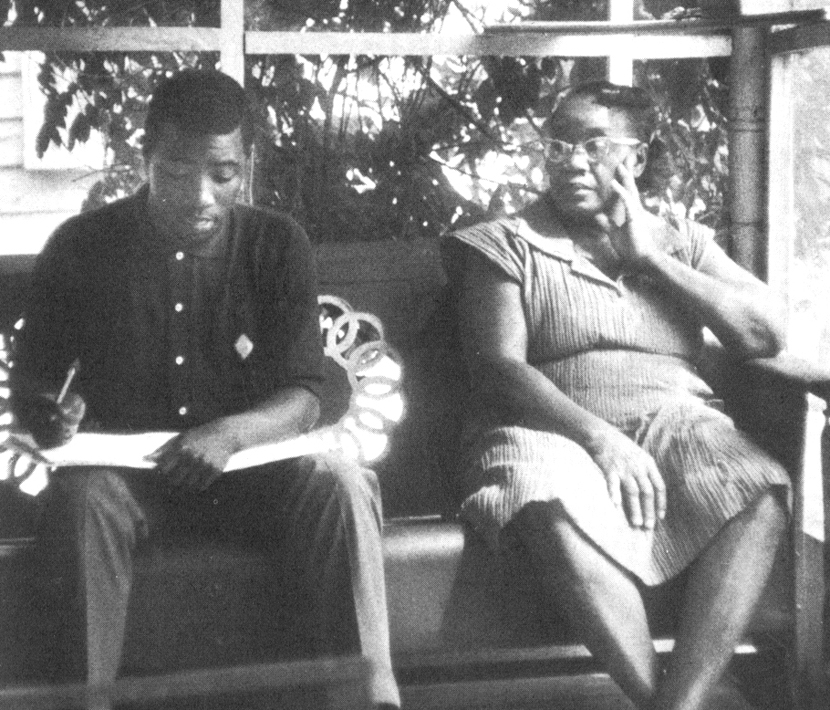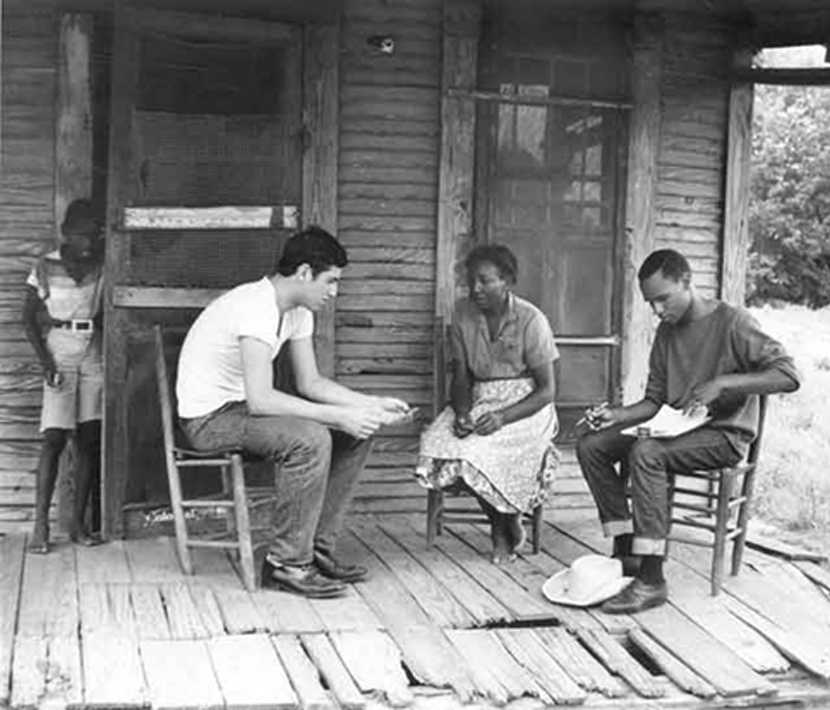Project Description
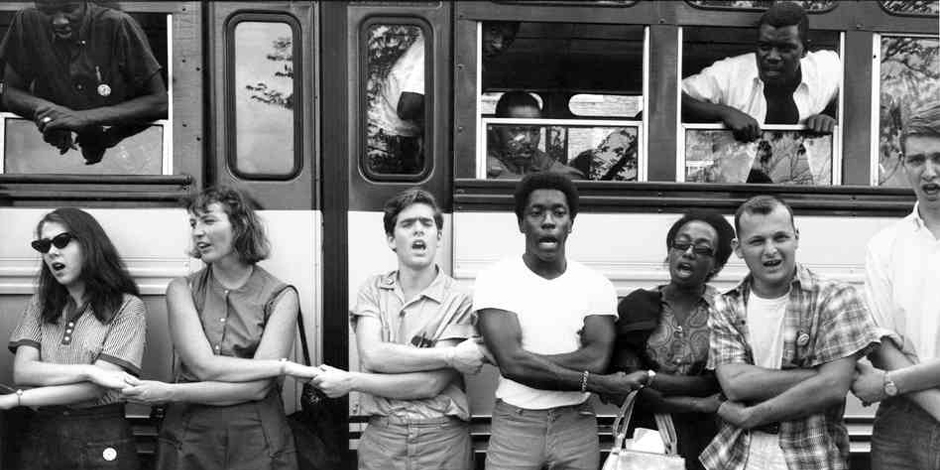
Photograph; Freedom Summer activists sing before leaving training sessions at Western College for Women in Oxford, Ohio, for Mississippi in June 1964. | Ted Polumbaum Collection/Newseum
100 Amazing Facts About the Negro: A new documentary reminds us of an old fight, with contemporary relevance.
Editor’s note: For those who are wondering about the retro title of this black-history series, please take a moment to learn about historian Joel A. Rogers, author of the 1934 book 100 Amazing Facts About the Negro With Complete Proof, to whom these 'amazing facts' are an homage.
Amazing Fact About the Negro No. 85: Why was the summer of 1964 pivotal in the fight for civil rights?
Tomorrow night, you will have an opportunity to experience “Freedom Summer” the way my family did: on television. Only back then, we didn’t know whether civil rights workers James Chaney, Andrew Goodman and Michael Schwerner would be found alive down in Mississippi. We also didn’t know whether the Civil Rights Act of 1964 (our subject next week), without badly needed voting-rights protections, would begin to fulfill Dr. Martin Luther King Jr.’s dream of a new American racial order, following a hundred years’ war between advocates for full and equal black citizenship and the architects of all the snares that had hampered black progress since the collapse of Reconstruction in 1876. What we did sense was that the movement had grown younger, more radical, more diverse and increasingly powered by what Robert “Bob” Parris Moses, the pivotal planner of Freedom Summer, has called “We, the people’ force.”
Before Sly and the Family Stone released their hit song “Everyday People,” the volunteers of Freedom Summer lived the philosophy behind it—school by school, vote by vote, blow by blow. Moses—truly one of the heroes in the history of the African-American people—compared “the language” animating this noble effort to that “of the ocean, the everyday language of everyday people.” And when its wave crashed in Mississippi in June, July and August of 1964, the reverberation was so loud and deep that we could hear it and feel it all the way up in the Allegheny Mountains surrounding my small hometown of Piedmont, W.Va.
One thing was for sure: None of us would ever be the same. Nor would America. To me, Freedom Summer’s greatest legacy is the counterintuitive philosophy behind it. After decades of a “top down” organizing strategy, Moses and Ella Baker flipped the script, galvanizing everyday people to learn and lead themselves. And it is—it always will be—a blueprint for change.
The Roots of Freedom Summer
Local branches of the NAACP led the way in Mississippi, beginning in the 1950s, with Amzie Moore, Aaron Henry and Medgar Evers (who would be assassinated in his own driveway) in the forefront. The mountains those pioneers had to climb were steep and jagged. African Americans in Mississippi, when they had jobs, were typically stuck working as sharecroppers or domestics, and they lived in a segregated society without any political power. “In 1962,” Lisa Clayton Robinson notes in her entry on Freedom Summer in Africana, “only 6.7 percent of African Americans in the state were registered to vote, the lowest percentage in the country.” And, as the 1955 murder of Emmett Till demonstrated, white violence was an omnipresent threat.
Organizers from the Student Nonviolent Coordinating Committee (SNCC) and the Congress of Racial Equality (CORE) started pouring into the state in the early 1960s. As President John F. Kennedy said about the country as a whole, “ … the torch ha
Born in Harlem in 1935, Moses grew up the son of an armory janitor and a mother who made a point of checking books out of the New York Public Library’s Harlem branch (now the Schomburg Center) every Friday. A graduate of Stuyvesant High School and Hamilton College in New York, Moses was well on his way to earning his Ph.D. at Harvard in the late 1950s when his mother died and his father was hospitalized. On leave, Moses taught math at the Horace Mann School in the Bronx, when he began collaborating with civil rights leader Bayard Rustin, who encouraged him to take a more active role in the movement. Moses wanted to make a difference in the lives of others—not by standing out, but by helping others help themselves. Besides Rustin, Moses’ mentors included the dynamic Ella Baker, Amzie Moore and C.C. Bryant, and he counted among his influences the pacifist teachings of the Quakers and the writings of the French existentialist philosopher Albert Camus.
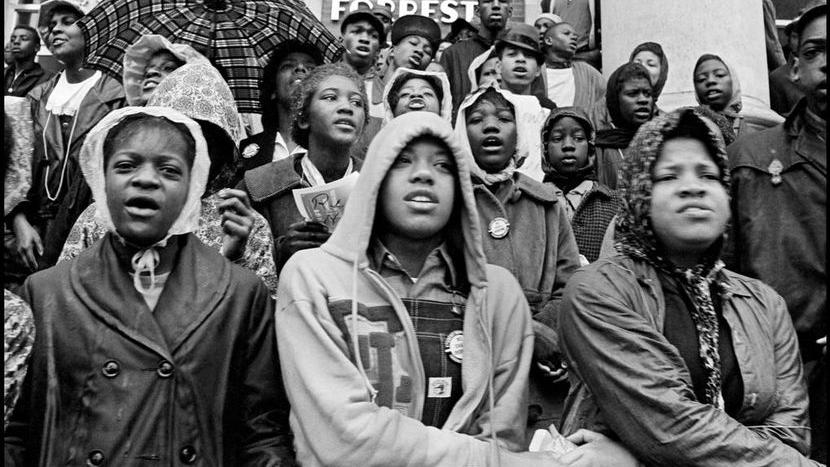
The Council of Federated Organizations
The arrival of activists such as Moses angered white Mississippians. NAACP leaders also were upset, fearing the newcomers would take control of the local movement they had been building. To make peace, Moses helped to form a new group, the Council of Federated Organizations (COFO), which brought together SNCC, CORE and the local NAACP branches, as well as the Southern Christian Leadership Conference and local community groups.
Determined to open a new front against Jim Crow in Mississippi, Moses and fellow COFO leader Dave Dennis hoped to recruit Northern white college students to the crusade. Again, they aroused suspicion from other movement leaders who were concerned that bringing in untrained white workers would divert attention from local needs. And it could prove quite dangerous. But the COFO plan was precisely about that: attracting attention, as Dennis explained in Howell Raines’ 1974 oral history My Soul Is Rested: “[T]he death of a white college student would bring on more attention to what was going on than for a black college student getting it. That’s cold, but that was also in another sense speaking the language of this country.”
The COFO leaders voted in favor of the summer project in January 1964. But the problems of bringing in white volunteers were immediately apparent. At an orientation meeting in Oxford, Ohio, whites laughed at the buffoonish image of a violent white sheriff. SNCC workers were incensed, with one warning, “Just wait until they break your head in,” as John Dittmer relates in his 1994 book Local People: The Struggle for Civil Rights in Mississippi. Others feared that white college students would intimidate local activists. As SNCC leader James Forman recalled, according to Dittmer: “One of our project directors … began to feel ashamed of the fact that he had completed only the sixth grade in school and told people he had graduated from college.”
Dittmer profiled the average Northern volunteer as “white, affluent, politically liberal, and enrolled at a prestigious university. Just how many volunteers worked in Mississippi is subject to conjecture, for COFO never compiled a final tally. … Probably no more than 650 students worked in Mississippi, and not all of those people worked all summer.” For the most part, as Doug McAdam writes in his 1988 book Freedom Summer, “the volunteers lived in communal ‘Freedom Houses’ or were housed by local black families who refused to be intimidated by segregationist threats of violence.”
Dittmer provides a specific example of a white volunteer living with a black family in Holmes County: “After one bombing scare Margaret Rose, a white freedom school teacher, reported that the family she was staying with ‘were up all night, Mr. on the road patrolling with his new rifle and Mrs. walking from room to room in the house with a shot gun, peering out of every window.’ Later Rose looked into the bedroom where one of the children lay sleeping, and ‘on the bed next to her was a large shot gun, waiting.’ ”
As McAdam relates, on July 30, 1964, the Jackson Clarion-Ledger published an editorial titled “Mississippi Invasion,” incorrectly blaming the influx of Northern volunteers on the Communist Party: “Those who know the ways of propaganda, especially of a Communist nature, probably correctly suspect that idealism of some college youngsters has been taken advantage of by some very hard boiled left-wingers and Communists who know exactly what they want to do—stir up trouble in the South.”
In this climate, Freedom Summer began with horrific violence. Activists Andrew Goodman, James Chaney and Michael Schwerner disappeared June 21 while investigating the burning of a church in Philadelphia, Miss. Chaney was an African American from Mississippi, and Goodman and Schwerner were white Jewish men from New York. And the violence was widespread. As Charles Payne writes in his 1995 book I’ve Got the Light of Freedom, “In just the first two weeks of the summer project, in addition to the [murders], there were at least seven bombings or fire-bombings of movement related businesses and four shootings and a larger number of serious beatings.”
It wasn’t until Aug. 4 that the tortured, brutalized bodies of Chaney, Goodman and Schwerner were discovered buried in a dam—slain by Klansmen with the knowledge of local police officers. Thirteen years old at the time, I became convinced that the deep South was a black hole from which the brave did not return. But there was soul force there, too. And, as it would turn out, nobody was going to stop it.
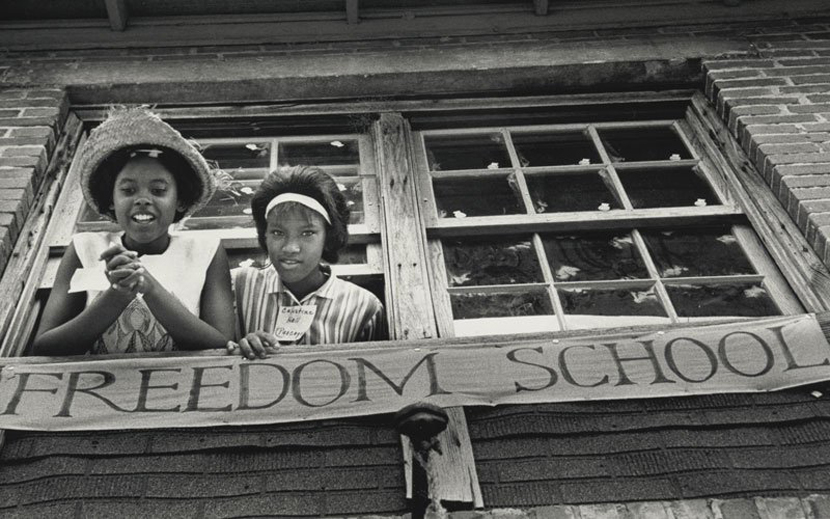
Photograph; “The atmosphere in the class is unbelievable. It is what every teacher dreams about — real, honest enthusiasm and desire to learn anything and everything. The girls come to class of their own free will. They respond to everything that is said. They are excited about learning. They drain me of everything that I have to offer so that I go home at night completely exhausted but very happy in spirit…” ~ Pam Parker, Freedom School teacher.
Freedom Schools
COFO activism during Freedom Summer proceeded along two tracks: freedom schools and voter registration drives. Freedom schools were the brainchild of Howard University student and SNCC leader Charles Cobb, who interpreted the mission of the schools broadly. In a 1963 proposal, he described his vision of “an educational experience for students which will make it possible for them to challenge the myths of our society, to perceive more clearly its realities, and to find alternatives and ultimately, new directions for action.” One can almost hear the voice of the great historian Carter G. Woodson, the founder of Negro History Week in 1926, working through him.
Freedom school students learned about black history and the civil rights movement. Cobb had planned for the schools to host 1,000 students, but, as Payne writes, “somewhere between twenty-five hundred and three thousand students actually showed up, and their ages ranged from seven to seventy. … [T]he number of schools was increased from twenty-five to forty-one.” Black children and adults attended freedom schools knowing they ran the risk of white retaliation. For instance, as Dittmer notes in his book, “The morning after a bomb leveled the church serving as the McComb freedom school, seventy-five students showed up for class on the lawn in front of the smoldering ruins.”
Voter Registration and Mississippi Freedom Democratic Party
Another of Moses’ bold moves in Mississippi was organizing a shadow election to demonstrate the eagerness of blacks to vote and the impact they would have at the polls if they could. Some 80,000 black Mississippians participated in the exercise, held in 1963.
The following year, during Freedom Summer, Moses and the COFO hoped to build on the momentum steadily generating from within the community by establishing the Mississippi Freedom Democratic Party as an alternative to the state’s whites-only Democratic Party. Their goal: to send a delegation to the Democratic National Convention in Atlantic City and to try to convince the party’s credentials committee “that blacks had been excluded from the ‘regular’ party and that the FDP was the only party in the state loyal to the national ticket,” Dittmer explains in paraphrasing civil rights lawyer Joseph Rauh. In all, 64 blacks and four whites arrived in Atlantic City on Aug. 21, 1964, under the MFDP banner.
But once there, they encountered a problem—a big problem: President Lyndon B. Johnson, who was desperate not to lose white support in the South ahead of his general election against conservative Republican Barry Goldwater, opposed the MFDP’s efforts. He even instructed the FBI to spy on the delegates. LBJ didn’t broach opposition: He was the party’s nominee, and this was his convention.
That didn’t keep the MFDP delegates, however, from testifying before the credentials committee. I vividly remember watching the live broadcast on network TV as COFO activist and former sharecropper Fannie Lou Hamer electrified the nation with her eloquent, passionate speech in favor of seating the delegates. “If the freedom party is not seated now, I question America,” Hamer thundered. “Is this America, the land of the free and the home of the brave, where we have to sleep with our telephones off the hooks because our lives be threatened daily, because we want to live as decent human beings in America?”
No one appreciated the power of Hamer’s testimony more, I suppose, than President Johnson. He abruptly had her national press coverage interrupted by spontaneously announcing that he would be giving his own speech from the White House—a speech that had absolutely no meaningful content! He just wanted Americans to turn off their TV screens from Hamer, and he succeeded. LBJ’s point man in Atlantic City was his running mate, Sen. Hubert Humphrey of Minnesota, who presented a compromise plan by which the MFDP would receive two at-large seats while the others would be “welcomed as honored guests,” according to Dittmer. In addition, the white delegates from the Democratic Party of Mississippi would be required to sign a loyalty oath.
Not surprisingly, the MFDP rejected the plan, and most of the white Mississippi delegation walked out. Then, after gaining their credential passes from sympathetic delegates from other states, MFDP members staged a protest sit-in on the convention floor. Again, Humphrey tried to get the delegates to compromise, and this time, in a maneuver some in the movement would never forgive, Bayard Rustin argued that they should take it. But again the MFDP refused, with Hamer summing things up as only she could: “We didn’t come all this way for no two seats.” Cold winds were blowing across Atlantic City’s boardwalk; Freedom Summer was coming to an end.
That fall, Johnson won a full term in a landslide victory and a year later signed the Voting Rights Act of 1965 after more blood was spilled in Selma, Ala. “The measure dramatically increased voter registration in the short term,” the U.S. House of Representatives website states. “By 1969, 60 percent of all southern blacks were registered. Predictably, the bill’s impact was most dramatic in the Deep South. In Mississippi, for instance, where less than 7 percent of African Americans qualified to vote in 1964, 59 percent were on voter rolls by 1968.”
Freedom Summer had left its mark. Clayton Robinson’s entry on Freedom Summer in Africana notes what Hamer said about it, looking back: “Before the 1964 project there were people that wanted change, but they hadn’t dared to come out. After 1964 people began moving. To me it’s one of the greatest things that ever happened in Mississippi.”
At the same time, the failure of the MFDP in Atlantic City left the SNCC, and indeed much of the civil rights movement, in crisis. “Never again were we lulled into believing that our task was exposing injustices so that the ‘good’ people of America could eliminate them,” SNCC activist Cleveland Sellers wrote in his 1973 memoir, The River of No Return. “After Atlantic City, our struggle was not for rights, but for liberation.” Two summers later, at a nighttime rally in Greenwood, Miss., SNCC leader Stokely Carmichael would begin speaking the electrifying language of “black power.” A new era had begun.
Freedom Summer Today
Earlier this year, in a recorded interview with former SNCC leader Julian Bond, Bob Moses named literacy and education as the “unfinished legacy” of 1964. As the U.S. Supreme Court continues to turn its back on the broad, democratic spirit of Brown v. Board of Education, I hope that young people learning about Freedom Summer for the first time will be inspired to volunteer in programs like AmeriCorps, Teach for America and Moses’ own Algebra Project. Fortunately, they have men like Bob Moses as role models.
Moses started his boldly innovative Algebra Project in 1982 with his MacArthur “genius” grant, aiming to reform the educational opportunities afforded poor black youth. An honorary degree recipient from Harvard in 2006, Moses continues to teach math today.
Let Moses’ genius be our guide: that the best and only way to effect meaningful, long-lasting change is to train and empower others to make their world anew. The traditional top-down model has a number of limits and has often been based on a condescending attitude of so-called leaders toward so-called followers. Change from the ground up is change that will last. By using that approach, we will live up to Moses’ example and that of the late Victoria Gray Adams, a founder of the Mississippi Freedom Democratic Party, who believed in her heart that “freedom summer never really ended.”
The documentary “Freedom Summer” airs on PBS starting tomorrow night (9 p.m. EST on most stations), and I hope you will join me in watching. Also, if you’re in New York this week, please don’t miss the final performances of the Tony-winning play All the Way, written by Robert Schenkkan and starring Bryan Cranston (who also took home a Tony for his portrayal of LBJ). In the play’s second act, you’ll see President Johnson in the Oval Office, working the politics of civil rights and his upcoming election, while behind him onstage, an open grave serves as a reminder of the gash that the deaths of Chaney, Goodman and Schwerner left and the hole out of which the nation had to climb. We are still climbing today.
As always, you can find more “Amazing Facts About the Negro” on The Root, and check back each week as we count to 100.
Henry Louis Gates Jr. is the Alphonse Fletcher University Professor and founding director of the Hutchins Center for African and African American Research at Harvard University. He is also editor-in-chief of The Root. Follow him on Twitter and Facebook.
